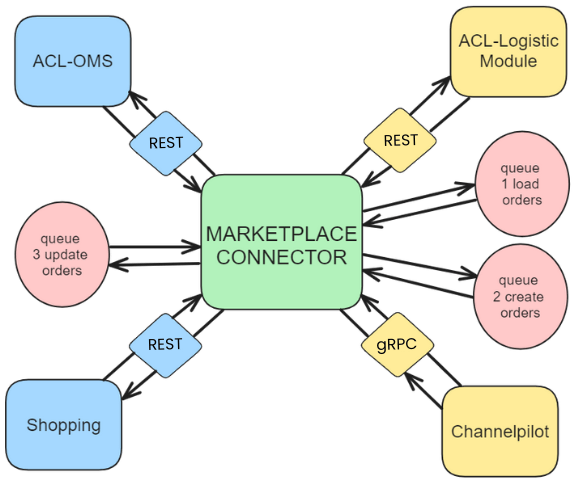For this project, we have implemented the Clean Architecture design principles. The functionality has been separated into different Maven modules. Each module either implements interfaces or utilizes existing implementations from the marketplace-connector module, which contains common classes.
Additionally, we have an aggregator-module that houses the application properties and serves as the main class for the Spring Boot application. This module is responsible for defining the specific modules (implementations) to be used during software deployment based on Maven profiles.
Spring Boot:
is a Java-based framework that simplifies the development of stand-alone, production-grade Spring-based applications. It provides a convention-over-configuration approach, reducing the need for boilerplate code. With embedded servers, easy configuration, and a wide range of built-in functionalities, developers can quickly build and deploy applications. Spring Boot embraces microservices architecture, promoting modularity and scalability. It integrates seamlessly with the Spring ecosystem and external libraries. Its opinionated defaults facilitate rapid development, making it an ideal choice for building robust, scalable, and efficient Java applications.
PostgreSQL:
is a powerful open-source relational database management system (RDBMS). Known for its extensibility, standards compliance, and ACID compliance, PostgreSQL supports a wide range of data types and features advanced indexing for optimal query performance. It includes support for complex queries, transactions, and stored procedures, making it suitable for enterprise-level applications. PostgreSQL's extensibility allows users to define custom data types, operators, and functions. With a robust security model and active community support, it is a popular choice for data-driven applications, offering scalability and reliability. Its versatility spans from small projects to large-scale, high-performance databases in diverse environments.
JPA:
is a powerful open-source relational database management system (RDBMS). Known for its extensibility, standards compliance, and ACID compliance, PostgreSQL supports a wide range of data types and features advanced indexing for optimal query performance. It includes support for complex queries, transactions, and stored procedures, making it suitable for enterprise-level applications. PostgreSQL's extensibility allows users to define custom data types, operators, and functions. With a robust security model and active community support, it is a popular choice for data-driven applications, offering scalability and reliability. Its versatility spans from small projects to large-scale, high-performance databases in diverse environments.
GRPC:
or Remote Procedure Call, is an open-source framework developed by Google for building efficient and scalable distributed systems. It uses a language-agnostic protocol, Protocol Buffers (protobuf), to define service contracts and messages. gRPC enables communication between applications across different environments, making it suitable for microservices architectures. It supports multiple programming languages, such as Java, Python, and C++, and provides features like bidirectional streaming, multiplexing, and pluggable authentication. gRPC promotes high-performance communication by using HTTP/2 as the underlying transport protocol, allowing for smaller payloads and efficient multiplexing of requests over a single connection.
Protobuf:
Protocol Buffers (Protobuf) is a language-agnostic data serialization format developed by Google. It enables efficient and extensible communication between systems and is widely used for RPC (Remote Procedure Call) and data exchange. Protobuf messages are defined in a simple language-agnostic interface description file, and the serialized data is compact, making it faster and more space-efficient than alternatives like JSON. With support for multiple programming languages, including Java, Python, and C++, Protobuf offers flexibility and interoperability. It is commonly used in distributed systems, microservices, and communication between different components, providing a streamlined and performant approach to data serialization.
RabbitMQ:
is an open-source message broker software that facilitates communication between distributed systems. It implements the Advanced Message Queuing Protocol (AMQP) and provides a reliable, scalable, and asynchronous messaging platform. RabbitMQ allows applications to exchange data in the form of messages, ensuring decoupling and flexibility in system architectures. It supports various messaging patterns, including point-to-point, publish/subscribe, and request/reply. RabbitMQ efficiently handles message queues, ensuring reliable delivery even in the presence of system failures. With client libraries in multiple programming languages, RabbitMQ is widely used for building scalable and loosely-coupled distributed systems in cloud and enterprise environments.
Redis:
is an open-source, in-memory data store that serves as a key-value database, cache, and message broker. Designed for high performance, it stores data in RAM, enabling fast read and write operations. Redis supports various data structures like strings, hashes, lists, sets, and more, making it versatile for diverse use cases. Its advanced features include data persistence, replication, and partitioning for scalability. Widely used for caching in web applications, real-time analytics, and queuing systems, Redis provides a simple yet powerful solution for managing and processing data rapidly, enhancing performance and responsiveness in distributed and high-throughput environments.
Grafana:
is an open-source analytics and monitoring platform that visualizes and analyzes metrics and logs from various data sources. It supports diverse data backends, including popular databases, cloud services, and monitoring systems. Grafana enables users to create customizable, interactive dashboards with real-time data, helping teams monitor and analyze system performance, application metrics, and logs. With a user-friendly interface and extensive plugin support, Grafana is widely used in DevOps, IT operations, and business intelligence. It plays a crucial role in enhancing data-driven decision-making by providing a unified and visually intuitive platform for monitoring and understanding complex systems.
Loki:
is an open-source log aggregation system designed for cloud-native environments. Developed by Grafana Labs, it integrates with Prometheus and is part of the CNCF (Cloud Native Computing Foundation). Loki focuses on efficiently collecting, indexing, and querying log data with a horizontally scalable architecture. It utilizes labels and a unique indexing approach to reduce storage costs while maintaining query speed. Loki is often used in conjunction with Grafana to create powerful and flexible log monitoring solutions. With its lightweight footprint and compatibility with Kubernetes, Loki is well-suited for modern, containerized applications seeking efficient log management.
Docker:
is an open-source platform that automates application containerization, allowing developers to package applications and their dependencies into portable, lightweight containers. These containers ensure consistent deployment across diverse environments, from development to production. Docker simplifies the creation, distribution, and deployment of applications by encapsulating them with all necessary components. It utilizes container technology to isolate processes, ensuring efficient resource utilization and scalability. Docker has become a cornerstone in modern DevOps practices, enabling rapid and reliable software delivery. Its simplicity, scalability, and compatibility make Docker a widely adopted solution for building, shipping, and running applications in a consistent and reproducible manner.
CI/CD:
Continuous Integration and Continuous Deployment is a software development approach that automates and streamlines the delivery pipeline. CI involves automatically integrating code changes into a shared repository, ensuring early detection of integration issues. CD extends this by automating the deployment process, allowing rapid and reliable releases. Developers commit code changes regularly, triggering automated build, test, and deployment processes. CI/CD practices enhance collaboration, reduce manual errors, and accelerate software delivery, enabling organizations to iterate and release software more frequently. This approach is crucial in agile development, promoting efficiency, reliability, and faster time-to-market for software products.
Vault:
is an open-source tool by HashiCorp designed for secure secret management and data protection. It provides a centralized system for storing, accessing, and managing sensitive information such as passwords, API keys, and certificates. Vault features dynamic secret generation, encryption as a service, and access controls, enhancing security in modern infrastructure. It supports various authentication methods and can integrate seamlessly with cloud providers and identity management systems. With capabilities like leasing, auditing, and dynamic secrets, Vault helps organizations implement robust security practices, ensuring the confidentiality and integrity of sensitive data in both on-premises and cloud environments.
Technologies
Spring Boot
PostgreSQL
JPA
GRPC
Protobuf
RabbitMQ
Redis
Grafana
Loki
Docker
CI/CD
Vault


